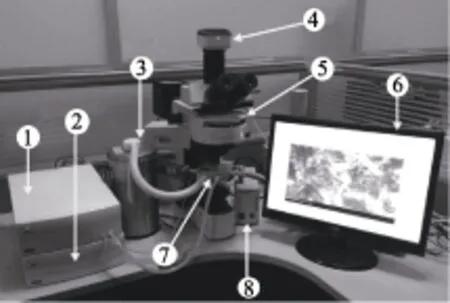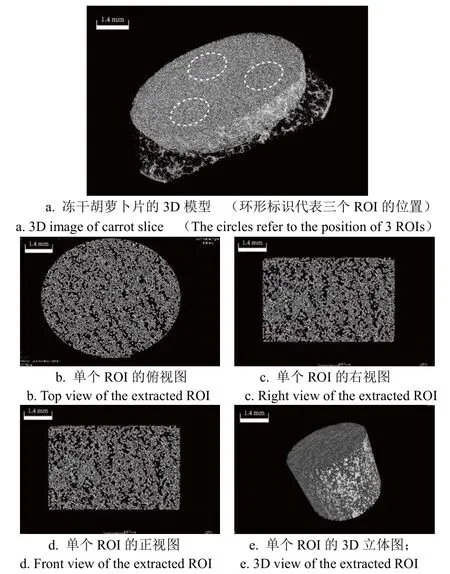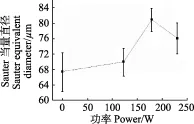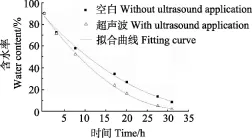超声波平板冷冻提高胡萝卜冻干速率
周新丽,滕 芸,戴 澄
(上海理工大学医疗器械与食品学院,上海 200093)
·农产品加工工程·
超声波平板冷冻提高胡萝卜冻干速率
周新丽,滕 芸,戴 澄
(上海理工大学医疗器械与食品学院,上海 200093)
为了探究接触式超声波辅助平板冷冻法对固体果蔬冻干过程的影响,该文研究了接触式超声波辅助胡萝卜的平板冷冻过程。首先,利用低温显微镜证实了接触式超声波能够有效促进平板冷冻固体果蔬样品成核,并且冰晶的形态与成核温度呈显著相关性(相关系数0.99),即成核温度越高,冰晶尺寸越大。其次,研究了超声波作用参数(功率,作用时间)对胡萝卜冰晶尺寸以及冻干速率的影响。结果表明,在胡萝卜样品厚度为5 mm,样品冷冻温度为-1℃时施加178.7 W功率的超声波10 s能显著提高(P<0.05)样品的成核温度,使冻干胡萝卜的孔隙当量直径从无超声波辅助条件下对照组样品的(66.29±3.58) µm提高到了(80.81±3.03) µm,同时干燥至实际含水率为10 %时,升华干燥速率提升了29.1%。该研究为接触式超声波辅助平板冷冻用于果蔬样品的冻干过程提供了有益参考。
超声波;成核;干燥;冻干速率;胡萝卜
0 引 言
冻干果蔬作为一种可以最大程度地保存食品原有营养价值与感官品质的干制果蔬产品越来越受到消费者的欢迎。但冷冻干燥工艺由于其干燥时间长、能源成本高等因素,极大限制了其在食品消费领域的普及。在冷冻干燥工艺中,冷冻是指在一定的过冷度下水转变为冰晶的过程,这个过程是决定冰晶形态、尺寸与分布的关键阶段,影响着冻干工艺与冻干食品的最终质量[1-3]。近年来许多新兴技术,例如高压冷冻[4-6]、成核剂[7-9]、电场[10-12]、微波辅助冷冻[13-16]等都被应用于控制冷冻过程。功率超声波作为一个低温非接触式的加工技术也被认为是促进成核的有效方法,它通过提升样品成核温度产生较大的冰晶,大冰晶在升华过程中形成较大的通道,从而达到提升升华干燥效率的目的。Chalmers[17]发表了第一篇超声波能促使冰晶在一个较高的温度下成核的研究。随后,许多相关研究开始证实超声波可以对过冷水和水溶液冷冻过程产生影响[18-21]。Nakagawa等[22]在其研究中发现成核温度与一次干燥速率间有很强的相关性,即干燥速率随成核温度的升高而增大,后进一步证实成核温度是决定一次干燥速率的主要因素[23]。
目前在超声波辅助冷冻的研究中,超声波的作用方式大致分为两种:一种是通过超声波水浴向样品传递超声波,即浸渍冷冻;另一种是样品本身即为液体。这是由于液体与声波间的声阻抗很低十分利于超声波的传播。而声能在食品组织中的传播效率并不高,这就解释了为什么辅助成核的试验对象很少为固体样品。但在冷冻干燥工业中,冷冻是通过冷板来实现的,因此用液体作为超声波的传播环境显然是不现实的。另一方面,一些科学家也进行了直接接触超声波促进对流干燥过程的研究。Gallego-Juárez等[24]利用超声波与果蔬直接接触的方法,也就是“直接接触超声波”向对流干燥中的果蔬作用超声波。试验发现超声波的施加不仅能够加快果蔬的脱水速度,同时可以实现降低干燥温度,减小能源消耗。Schössler等[25]在冻干果蔬升华干燥的过程中将样品置于超声波震动网格,间歇性地向样品施加“直接接触超声波”,研究发现在超声波的辅助下果蔬的干燥速率有显著提升(P<0.05)。
结合以上两方面的研究,本研究运用“直接接触超声波”来辅助胡萝卜片的冷冻过程,验证直接接触超声波对辅助固体样品成核的有效性以及对提升冷冻干燥速率的影响。首先利用低温显微镜,从微观上观察直接接触超声波对促进胡萝卜成核的有效性;随后在胡萝卜的冷冻干燥过程中,利用超声波平板实现超声波辅助胡萝卜平板冷冻,研究超声波作用参数(超声功率、作用时间)对胡萝卜冰晶尺寸以及冻干速率的影响,以期为接触式超声波辅助平板冷冻用于果蔬样品的冻干过程提供有益参考。
1 材料与方法
1.1 超声波促进结晶的显微观察
低温显微实验台由制冷系统和成像系统两大部分组成,系统中各组件如图1所示。制冷系统(BCS196,Linkam Scientific,英国)的部件包括冷热台,温度控制器,泵、液氮罐及温度控制软件(Linksys32,Linkam Scientific,英国);其中冷热台的冷却通过泵将液氮罐中的液氮输送至冷热台中的银台内部而实现,具体冷却温度由温度控制器和温度控制软件所控制,温度范围在-196~125 ℃可调。成像系统的部件包括光学显微镜(BX51,Olympus,日本)、摄影设备、及温度控制软件(Linksys32,Linkam Scientific,英国)。
将新鲜胡萝卜切成0.1 mm薄片,平整放置于银台。选用10倍目镜观察样品并调整视野和焦距。启动温度控制器使银台温度冷却至试验温度(-3、-4、-5、-6℃)且保持不变。等待60 s保证样品完全冷却至目标温度。打开工作频率为40 kHz的超声波发生器,利用超声波换能片触发样品成核,拍摄胡萝卜结晶图像并储存于电脑中。为了比较胡萝卜在不同成核温度下的冰晶尺寸,通过图像分析软件(Digimizer)定义并计算边界清晰的冰晶面积,利用公式(1)计算出各冰晶的面积当量直径(are equivalent diameter,AED)。

式中S为冰晶的面积,mm2。

图1 用于观察冰晶形态的低温显微镜试验台Fig.1 Cryo-microscope system for ice morphology observation
1.2 超声波辅助冻干
超声波辅助成核由自制超声波平板实现,如图2所示。设备由一个功率可调式超声波发生器(THD-2010A,深圳太和达科技有限公司,中国)、4个超声波振子以及一个不锈钢平板(长×宽20 mm×20 mm,厚度2 mm)组成。超声振子均匀地固定在不锈钢平板上。通过发生器可在0~240 W范围内调节超声波平板的输出功率。
将胡萝卜切成5 mm厚度的薄片,并用直径为33 mm的模具将胡萝卜切片压成大小均一的圆柱体,放入冰箱待用。将超声波平板放置于冷冻干燥机内的冷板上提前预冻2 h,预冷温度为-40 ℃。预冷结束后,从冰箱取出三片胡萝卜样品置于冷冻干燥机内的超声波平板上。任取其中一片于样品底部插入两根T型热电偶(SCPSS-040U-6,Omage,美国,精度:±0.5 ℃),用于温度监测。当样品温度降至-1 ℃时,开始向样品施加指定参数的超声波。施加完超声波后,关闭发生器使胡萝卜样品继续冷冻直至-30 ℃,随后移至温度为-40 ℃的低温冰箱,完成一组超声波作用的冻结过程。

图2 超声波平板设备图Fig.2 Experimental equipment for ultrasound-assisted freezing.
为了研究超声波作用的最佳工艺参数,试验选取了不同超声波功率以及不同超声波作用时间。具体试验参数如下:1)超声波功率:0、122.6、178.7、229.8 W,超声波作用时间固定为10 s;2)超声波作用时间:0、5、10、15 s,超声波功率固定为178.7 W。
所有的超声波作用组的冻结过程全部完成后,移去冻干机内的超声波平板,并将低温冰箱中的所有样品移回冻干机同时进行冷冻干燥。冷冻干燥的参数为:一次干燥温度-20 ℃,干燥时间31.5 h;二次干燥温度20 ℃,干燥时间2 h;真空度设置为40 Pa。干燥过程完成后,进行孔隙尺寸的测量。
1.3 冻干胡萝卜孔隙尺寸的测定
通过测量冻干胡萝卜的孔隙尺寸来间接表示胡萝卜样品中的冰晶大小。测定过程如下:将冻干胡萝卜放入工业CT机(XT H 320 LC X-ray System,尼康,日本)进行扫描,每个角度扫描一张,即扫描结束后每片冻干胡萝卜有360张2D扫描图。利用3D合成软件(CT Pro 3D)将所有的2D扫描图重构成3D模型,利用像素分析软件(VGStudio MAX 2.2)打开3D模型并对其进行分析。在模型中挖取出一个圆柱体,将其定义为感兴趣区域(region of interest,ROI),放大ROI直至可以看清孔隙(图3b~e),计算出孔隙的总体积和总表面积,代入公式(2)计算出孔隙的Sauter当量直径。由于整片冻干胡萝卜的孔隙数量太过庞大,软件无法一次性计算得出整片冻干样品的孔隙数据。因此,在冻干胡萝卜3D模型上均匀选择3个ROI进行计算,并取其平均值作为整片冻干样品的孔隙尺寸。

式中Stotal为孔隙度总表面积,mm2;Vtotal为孔隙的总体积,mm3。
1.4 含水率的测定
为了验证超声波辅助成核对升华干燥速率的作用,进行了如下试验:超声波样品组在优化的超声参数作用下冻结,空白样品组在无超声作用下冻结,两组样品各取25片,随后的干燥参数同1.2。干燥期间定时手动停止升华干燥过程,即释放冻干机中的真空,从两组样品中各取出 3 片进行含水率的测量,完成取样后开启真空泵将冻干机中恢复至40 Pa继续对剩余样品进行干燥,重复上述干燥过程直至干燥过程完成。绘制两组样品在干燥过程中的含水率变化曲线。样品的含水率用称量法进行测量,将取出的样品置于洗净干燥的称量瓶中进行称量,记为 W1(g),将装有样品的称量瓶放入 6 5 ℃烘箱中进行烘干处理4 h后,再置于105 ℃温度下烘干1 h,取出冷却至室温称量,再烘0.5 h后取出冷却并称量,反复至恒质量后(两次重量差不超过0.002 g即为恒质量),记为W2(g)。代入公式(3)计算含水率。

图3 冻干胡萝卜片的CT扫描图像Fig.3 CT scanning picture of freeze-dried carrot sample

式中W0为称量瓶质量,g;W1为湿质量加称量瓶质量,g;W2为烘干处理后样品加称量瓶质量,g。
2 结果与分析
2.1 低温显微镜下观察超声波辅助胡萝卜成核
图4显示了在不同成核温度(-3、-4、-5、-6 ℃)下胡萝卜冰晶的形态。从图 5 中可以清楚地发现,冰晶的形态与成核温度有显著相关性(相关系数0.99),成核温度越高,冰晶尺寸就越大。各成核温度下冰晶面积的当量直径如图5所示,在-6 ℃的成核温度下,胡萝卜冰晶的平均面积当量直径为20.20 µm;而当成核温度升高至-3 ℃时,平均当量直径为33.16 µm,冰晶尺寸有很大的提升。另外试验过程中发现,在施加超声波与胡萝卜成核这两个时间点存在一定时间的延迟,也就是说当施加了超声波后,成核现象并没有马上发生。
Hickling[26]证明了由于空化气泡的崩溃产生一个瞬时的高压,造成平衡水冻结温度的升高,从而提高了成核温度。Geidobler等[27]分别在-5和-15 ℃的成核温度下观察冰晶的生长状况,发现在-5 ℃的成核温度下,冰晶数量少,尺寸大,冻结速率较慢;在-10 ℃的成核温度下,冰晶数量多,尺寸小,冻结速率快,且大部分冰晶是在一瞬间生成的。Nakagawa等[22]通过试验证明了成核温度与冰晶尺寸之间存在着相关性,即成核温度越高,冰晶尺寸越大;在-7.39 ℃下得到的冰晶平均当量直径为54.1 µm,而在-2.04 ℃的温度下的冰晶平均当量直径为122 µm,几乎是前者的两倍。但是关于冰晶大小与成核温度、超声功率之间的直接定量关系还未有报道,仍需要进一步的研究探讨[28]。

图4 在不同成核温度下的胡萝卜冰晶形态图Fig.4 Microscopy images of ice formed in carrot slice under different nucleation temperature

图5 在不同成核温度下胡萝卜冰晶的面积当量直径Fig.5 Area equivalent diameter of ice formed in carrot slice under different nucleation temperature.
2.2 超声波功率对冰晶尺寸的影响
图6显示了胡萝卜样品在-1 ℃时,施加了10 s不同功率(0、122.6、178.7、229.8 W)超声波后冰晶当量直径的变化。在没有超声波的辅助下,对照组样品的孔隙当量直径为(67.34±5.06)µm。在作用了122.6 W的超声波后,样品的孔隙直径有所上升,为(69.88±3.63)µm(P<0.05)。而当将178.7 W和229.8 W超声作用于样品时,孔隙的尺寸有了显著提高(P<0.05),分别为(80.81±3.03)µm和(75.98±4.10)µm(P<0.05),说明此时样品在冷冻阶段形成了较大尺寸的冰晶。但在229.8 W超声波作用下的冰晶尺寸却小于178.7 W组的样品,说明超声波的作用功率并非越高越好。高功率的超声波能在食品中产生热效应,且过多的热量不能马上从样品中被排除,就会影响样品达到足够的过冷度从而阻碍成核过程[29-30]。
2.3 超声波作用时间对冰晶尺寸的影响
图7显示了胡萝卜样品在-1 ℃作用了不同时间(0、5、10、15 s)178.7 W功率的超声波后冰晶当量直径的变化。如图所示,空白样品孔隙的平均当量直径为(66.29± 3.58)µm。在施加了5 s超声波后,孔隙当量直径提升至(71.22±3.43)µm(P<0.05)。当进一步增加作用时间至10 s时,冻干胡萝卜的孔隙尺寸又有了进一步提升为(80.64±3.02)µm。然而在大于10 s的超声波作用时间下,样品的孔隙当量直径开始减小,15 s降至(72.94± 2.91)µm。在辅助成核的过程中,需要根据试验对象与环境选择合适的超声波参数,以防产生反效果。在本试验中,超声波辅助胡萝卜成核的较佳作用参数为功率178.7 W,作用时间10 s,此条件下的样品孔隙当量直径为(80.64±3.02)µm。

图6 在不同功率超声波作用下冻干胡萝卜内的孔隙当量直径Fig.6 Equivalent diameter of voids in freeze-dried carrot under different ultrasound power levels

图7 不同超声波作用时间下冻干胡萝卜内的孔隙当量直径Fig.7 Equivalent diameter of voids in freeze-dried carrot under different ultrasonic time
2.4 超声波辅助成核对升华干燥速率的影响
图8可看出,当在升华干燥的最初3 h内,两组样品的干燥曲线几乎重合,说明此时间段两组样品的干燥速率相差不大。但超过3 h后,超声组的干燥曲线的下降速率明显高于空白组(P<0.05)。当第一次干燥进行至20.34 h,空白样品的含水率为25.69%,而超声波组的含水率已低至14.95%。根据两组样品的拟合干燥曲线,当实际含水率为10%时,超声组和空白组的干燥时间分别为22.59 h和31.85 h。相比于空白组,超声组的升华干燥速率提升了29.1%。这说明直接接触超声波能很好地与冷冻干燥过程结合,显著提升干燥效率。这与Rambhatla等[31]的理论相一致,他们得出冰晶的尺寸和干燥速率之间存在着一定的相关性,如公式(4)所示。

式中Rp为冻干层阻力,N;R为气体常数;T为绝对温度,℃;M为水的分子量;ε为孔隙率;r为孔隙半径,µm;τ为干燥层的曲折度(与通道长度及多孔介质厚度有关,约等于1.5 cm),1为冻干层厚度为1 cm。从这个公式可以看出,当r越大时,Rp越小,升华速率越大,则能有效缩短一次干燥速率的时间。

图8 超声波样品与空白样品的含水率Fig.8 Moisture content of carrot samples with and without ultrasound wave
2.5 样品厚度对超声波辅助成核影响的讨论
在本试验中胡萝卜片样品厚度为5 mm的情况下,根据对样品的孔隙分析发现,样品圆柱体上下两部分的孔隙大小并没有显著性差异(P<0.05)。但如果增加样品的厚度,将厚度提升至某一程度,会在样品内部产生温度梯度,样品内的冰晶大小则会产生轴向差异[32]。另外,由于超声波会在传输过程中产生声能衰减,且声能的强度随传输距离的增长呈指数衰减[33](公式5),因此随着样品厚度的增加,样品中远离声源的区域可能辐射不到足够强度的超声波,从而无法达到控制成核所需要的超声强度;在这种情况下需要一定程度地提高超声的辐射强度,但前提是不能在样品中产生过多的热量,影响成核的进程。在同时考虑到控制成核的有效性和冷冻干燥的生产效率,样品的厚度不宜过厚。

式中Ix为距离声源x处的声强,dB;I0为声源处的初始强度,dB;α为衰减系数,mm-1;x为距离声源的距离,mm。
3 结 论
本文通过接触式超声波辅助胡萝卜的平板冷冻过程,证实了直接接触超声波能够有效促进固体样品成核,提高成核温度,从而提升一次干燥效率。
1)通过低温显微镜观察发现,胡萝卜冰晶的形态与成核温度呈显著相关性(相关系数0.99),即成核温度越高,冰晶尺寸越大。
2)研究了超声波功率以及作用时间对胡萝卜样品平板冻结过程的影响,结果表明,在胡萝卜样品厚度为5 mm,样品冷冻温度为-1℃时施加178.7 W功率的超声波10 s能显著提高(P<0.05)样品的成核温度,使冻干胡萝卜的孔隙当量直径从无超声波辅助的对照组样品的(66.29±3.58) µm提高到(80.81±3.03)µm,当实际含水率为10%时,升华干燥速率提升29.1%。
3)超声波功率过低或作用时间过短对促进成核的作用都不够理想,而超声波功率过高或作用时间过长会由于热效应的产生而阻碍胡萝卜的成核过程。该研究为接触式超声波辅助成核用于果蔬样品的冻干过程提供了有益参考。
[1] Messina V,Pieniazek F,Sancho A. Effect of different freeze drying cycle in Semimembranous and Gluteus Medius bovine muscles:changes on microstructure,colour,texture and physicochemical parameters[J]. International Journal of Food Science &Technology,2016,51(5):1268-1275.
[2] Kiani H,Sun D W. Water crystallization and its importance to freezing of foods[J]. Trends in Food Science &Technology,2011,22(8):407-426.
[3] Parniakov O,Bals O,Lebovka N,et al. Pulsed electric field assisted vacuum freeze-drying of apple tissue[J]. Innovative Food Science &Emerging Technologies,2016,35:52-57.
[4] Savadkoohi S,Kasapis S. High pressure effects on the structural functionality of condensed globular-protein matrices[J]. International Journal of Biological Macromolecules,2016,88:433-442.
[5] Huang R,Ye M,Li X,et al. Evaluation of high hydrostatic pressure inactivation of human norovirus on strawberries,blueberries,raspberries and in their purees[J]. International Journal of Food Microbiology,2016,223:17-24.
[6] Petzold G,Aguilera J M. Ice Morphology:Fundamentals and Technological Applications in Foods[J]. Food Biophysics,2009,4(4):378-396.
[7] James C,Purnell G,James S J. A Review of Novel and Innovative Food Freezing Technologies[J]. Food &Bioprocess Technology,2015,8(8):1616-1634.
[8] Ribeiro A P B,Masuchi M H,Miyasaki E K,et al. Crystallization modifiers in lipid systems[J]. Journal of Food Science and Technology,2015,52(7):3925-3946.
[9] Li B,Sun D W. Novel methods for rapid freezing and thawing of foods:A review[J]. Journal of Food Engineering,2002,54(3):175-182.
[10] Parniakov O,Bals O,Lebovka N,et al. Effects of pulsed electric fields assisted osmotic dehydration on freezingthawing and texture of apple tissue[J]. Journal of Food Engineering,2016,183:32-38.
[11] Ammar J B,Lanoisellé J L,Lebovka N I,et al. Effect of a pulsed electric field and osmotic treatment on freezing of potato tissue[J]. Food Biophysics,2010,5(3):247-254.
[12] Petersen A,Rau G,Glasmacher B. Reduction of primary freeze-drying time by electric field induced ice nucleus formation[J]. Heat and Mass Transfer,2006,42(10):929-938.
[13] Woo M W,Mujumdar A S. Effects of electric and magnetic field on freezing and possible relevance in freeze drying[J]. Drying Technology An International Journal,2010,28(4):433-443.
[14] Ardestani S B,Sahari M A,Barzegar M. Effect of extraction and processing conditions on organic acids of barberry fruits[J]. Journal of Food Biochemistry,2015,39(5):554-565.
[15] Jermann C,Koutchma T,Margas E,et al. Mapping trends in novel and emerging food processing technologies around the world[J]. Innovative Food Science &Emerging Technologies,2015,31:14-27.
[16] Xanthakis E,Le-Bail A,Ramaswamy H. Development of an innovative microwave assisted food freezing process[J]. Innovative Food Science &Emerging Technologies,2014,26:176-181.
[17] Chalmers B. Principles of Solidification[M]. New York:John Wiley &Sons,1964.
[18] Kiani H,Zhang Z,Delgado A,et al. Ultrasound assisted nucleation of some liquid and solid model foods during freezing[J]. Food Research International,2011,44(9):2915-2921.
[19] Comandini P,Blanda G,Soto-Caballero M.C et al. Effects of power ultrasound on immersion freezing parameters of potatoes[J]. Innovative Food Science &Emerging Technologies,2013,18:120-125.
[20] Cheng X F,Zhang M,Adhikari B. Effect of ultrasonically induced nucleation on the drying kinetics and physical properties of freeze-dried strawberry[J]. Drying Technology,2014,32(15):1857-1864.
[21] Xu H,Zhang M,Duan X. et al. Effect of power ultrasound pretreatment on edamame prior to freeze drying[J]. Drying Technology,2009,27(2):186-193.
[22] Nakagawa K,Hottot A,Vessot S,et al. Influence of controlled nucleation by ultrasounds on ice morphology of frozen formulations for pharmaceutical proteins freezedrying[J]. Chemical Engineering and Processing:Process Intensification,2006,45(9):783-791.
[23] Nakagawa K,Hottot A,Vessot S,et al. Modeling of freezing step during vial freeze-drying of pharmaceuticals:Influence of nucleation temperature on primary drying rate[J]. Asia-Pacific Journal of Chemical Engineering,2011,6(2):288-293.
[24] Gallego-Juárez J A,Riera E,de la Fuente Blanco S. et al. Application of high-power ultrasound for dehydration of vegetables:processes and devices[J]. Drying Technology,2007,25(11):1893-1901.
[25] Schössler K,Jäger H,Knorr D. Novel contact ultrasound system for the accelerated freeze-drying of vegetables[J]. Innovative Food Science &Emerging Technologies,2012,16(39):113-120.
[26] Hickling R. Nucleation of freezing by cavity collapse and its relation to cavitation damage[J]. Nature,1965,206(4987):915-917.
[27] Geidobler R,Winter G. Controlled ice nucleation in the field of freeze-drying:Fundamentals and technology review[J]. European Journal of Pharmaceutics &Biopharmaceutics,2013,85(2):214-222.
[28] Saclier M,Peczalski R,Andrieu J. Effect of ultrasonicallyinduced nucleation on ice crystals’ size and shape during freezing in vials[J]. Chemical Engineering Science,2010,65(10):3064-3071.
[29] Kowalski S J,Pawłowski A,Szadzińska J,et al. High power airborne ultrasound assist in combined drying of raspberries[J]. Innovative Food Science &Emerging Technologies,2016,34:225-233.
[30] Cheng X,Zhang M,Adhikari B. Effects of ultrasoundassisted thawing on the quality of edamames frozen using different freezing methods[J]. Food Science and Biotechnology,2014,23(4):1095-1102.
[31] Rambhatla S,Ramot R,Bhugra C,et al. Heat and mass transfer scale-up issues during freeze drying:II. Control and characterization of the degree of supercooling[J]. Aaps Pharmscitech,2004,5(4):54-62.
[32] Rees Jones D W,Wells A J. Solidification of a disk-shaped crystal from a weakly supercooled binary melt[J]. Physical Review E,2015,92(2):022406.
[33] 王卫东,解维伟,张成联. 基于超声波衰减法煤泥水浓度检测的研究[J]. 选煤技术,2011(1):47-49. Wang Weidong,Xie Weiwei,Zhang Chenglian. The study of concentration measurement of coal slurry based on ultrasonic attenuation method[J]. Coal Preparation Technology,2011(1):47-49.
Contact ultrasound freezing improving freeze drying rate of carrot
Zhou Xinli ,Teng Yun,Dai Cheng
(School of Medical Instrument and Food Engineering,University of Shanghai for Science and Technology,Shanghai 200093,China)
Ultrasound can promote nucleation at higher temperatures,resulting in larger ice crystals. Thereby the sublimation time is significantly reduced. From all the researches,either ultrasound is applied in ultrasonic water bath or sample itself is liquid form since the low acoustic impedance between liquid and acoustic waves favors ultrasound transfer. However solid samples have barely been taken into account due to the poor transfer efficiency of ultrasound in food matrix. During the freeze drying process,the freezing is usually realized by shelf cooling in freeze-drier. Thus,using liquid as ultrasound applying media is not applicable. The technology currently is for liquid samples or adopts the immersion freezing process,but the plate freezing process for solid samples(fruits/vegetables) was barely taken into account. In this study,contact ultrasound-assisted plate freezing process was achieved. Firstly,the effect of direct contact ultrasound on inducing nucleation of solid samples was observed in the micro environment. Then a microscopic observation was carried out to examine the effectiveness of direct contact ultrasound on inducing nucleation for solid samples at different supercooling degree. The results showed that crystal morphology and nucleation temperature had significant correlation,namely the ice crystal size increased with the nucleation temperature. For example,under the nucleation temperature of -6 ℃,the average ice diameter was 20.20 µm,while the mean diameter increased up to 33.16 µm when the nucleation temperature was raised to -3 ℃. In addition,a phenomenon was found that there existed a postponement of nucleation after the onset of ultrasound application,in other words,nucleation did not follow the ultrasound triggering immediately. Secondly,the influences of ultrasonic parameters(power,exposure time) on the ice crystal size and freeze drying rate of carrot were investigated. The samples thickness was 5 mm. The results showed that applying 178.7 W power ultrasonic for 10 s at -1 ℃ could significantly increase the nucleation temperature,and make the void size of freeze-dried carrot increase from (66.29±3.58) to(80.81±3.03) µm,and the sublimation time was significantly reduced by 29.1% when the residual moisture was 10%. But it used the appropriate ultrasound irradiation condition to avoid the heat accumulation inside the food matrix. In addition,it was further verified that the primary drying rate was significantly reduced since the bigger crystals were formed in the presence of ultrasound. Therefore,the direct contact ultrasound is a promising technology in solid sample freeze-drying process. Finally,the influence of sample thickness on inducing nucleation was investigated. Under the sample thickness of 5 mm in this experiment,there was no significant difference between the void size of upper and lower part of the freeze-dried cake. But if larger thickness was considered,the freezing rate gradient within the sample may result in crystal size difference in axial direction. Smaller ice crystals may form at the region closer to the cooling plate since it was cooled faster than the interior. Furthermore,with the increase of thickness,the region far away from the vibrating plate may not be subjected to enough ultrasound radiation due to the acoustic attenuation within the sample and thus inducing nucleation would not be effective. Considering both inducing nucleation effectiveness and freeze drying efficacy,a maximum product thickness should not be too thick. These studies can provide a reference for the freeze drying process of samples(fruits/vegetables) by contact ultrasonic vibrating plate freezing.
ultrasound wave;nucleation;drying;freeze drying rate;carrot
10.11975/j.issn.1002-6819.2017.01.035
TS201.1
A
1002-6819(2017)-01-0256-06
周新丽,滕 芸,戴 澄. 超声波平板冷冻提高胡萝卜冻干速率[J]. 农业工程学报,2017,33(1):256-261.
10.11975/j.issn.1002-6819.2017.01.035 http://www.tcsae.org
Zhou Xinli,Teng Yun,Dai Cheng. Contact ultrasound freezing improving freeze drying rate of carrot[J]. Transactions of the Chinese Society of Agricultural Engineering(Transactions of the CSAE),2017,33(1):256-261.(in Chinese with English abstract)doi:10.11975/j.issn.1002-6819.2017.01.035 http://www.tcsae.org
2016-07-25
2016-08-15
国家自然科学基金(51376132)
周新丽,副教授,博士,主要研究方向为食品冷冻冷藏与冷冻干燥。Email:zjulily@163.com

